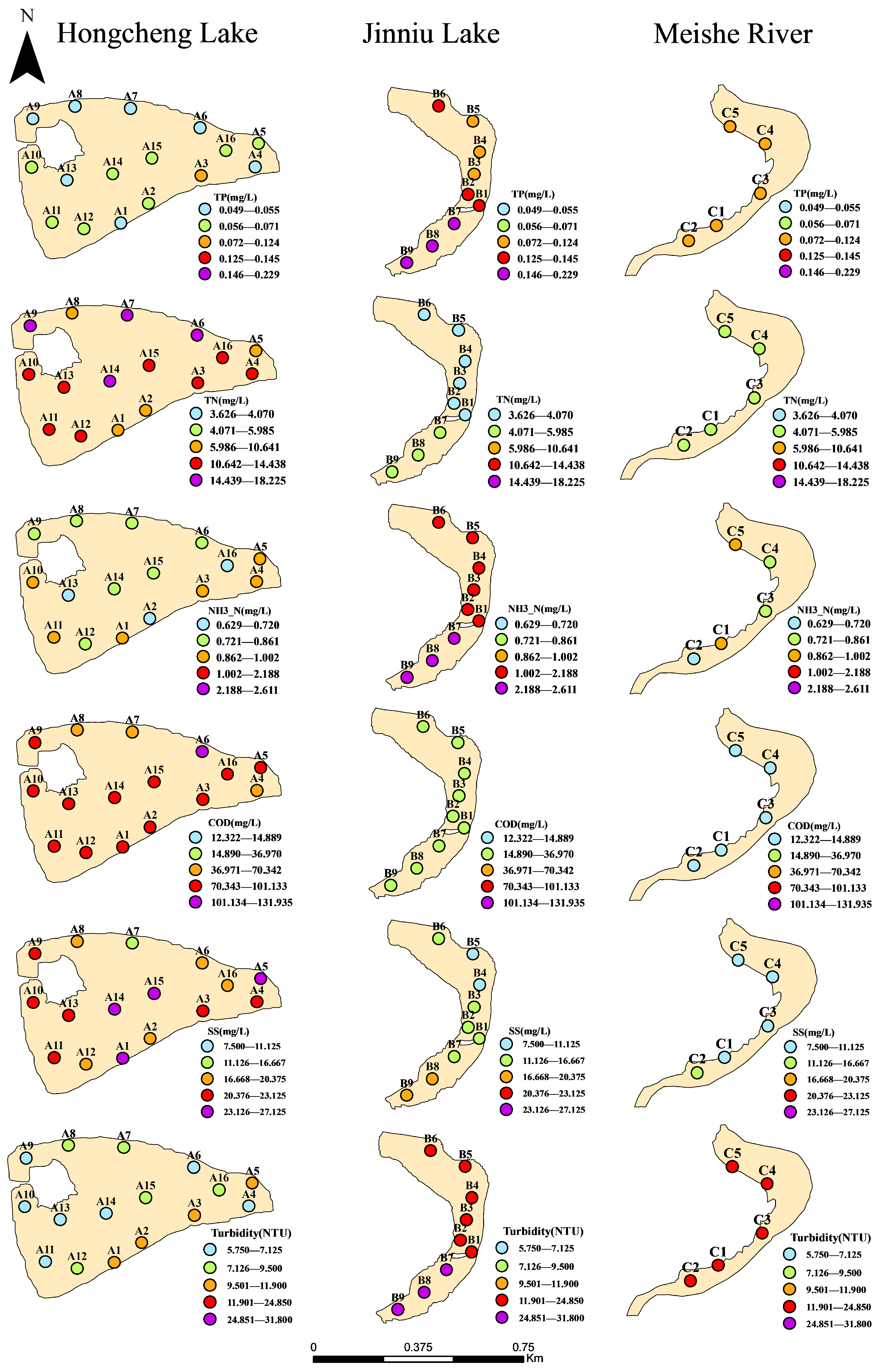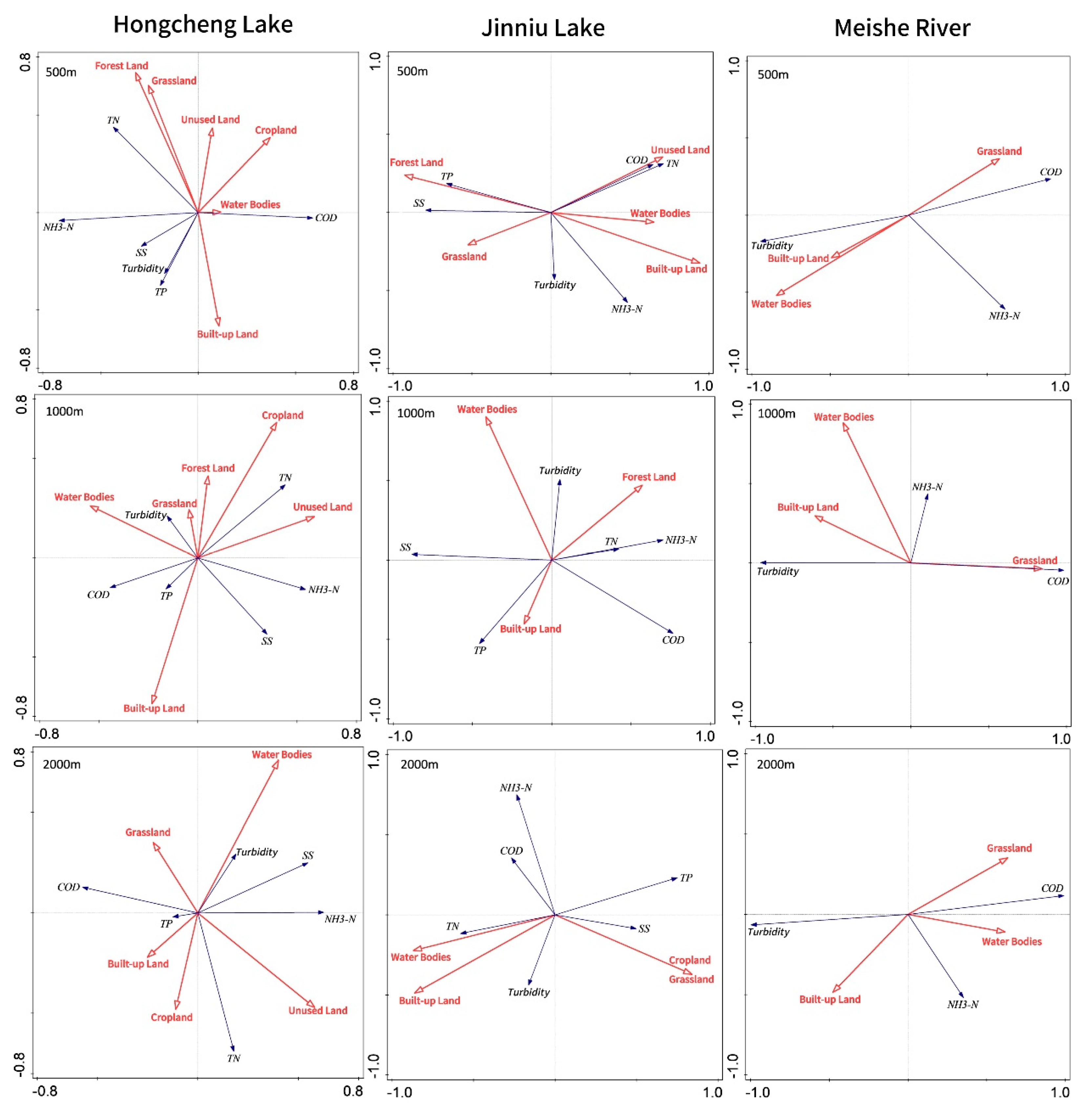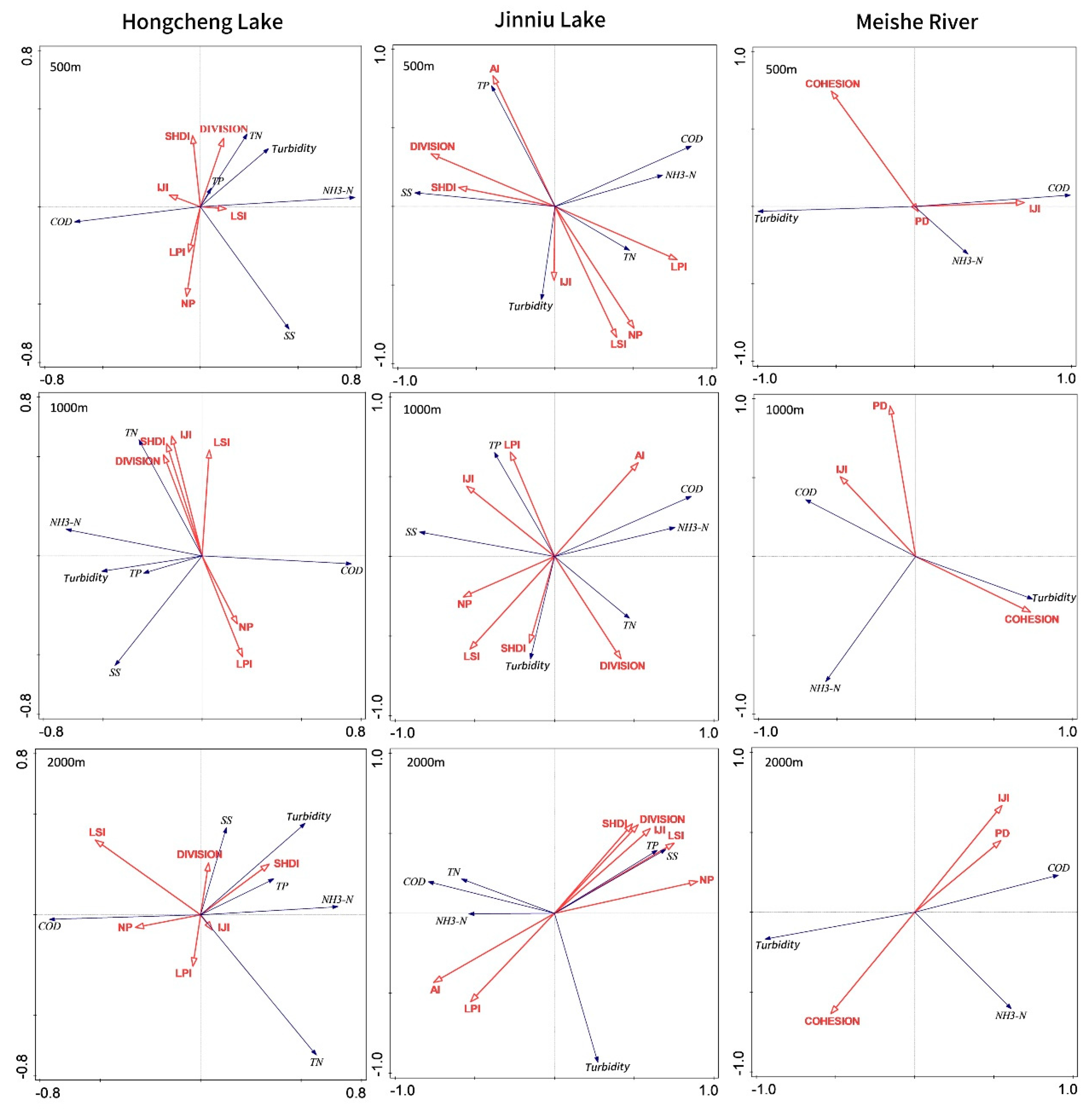3.3.1. Correlation Analysis of Landscape Composition and Water Quality Parameters
Spearman’s rank correlation analysis between landscape composition and water quality parameters for the urban water bodies was conducted using SPSS 27, with the results summarized in
Table 6,
Table 7 and
Table 8.
Hongcheng Lake: Built-up Land exhibited consistent positive correlations with Total Phosphorus (TP), Ammonia Nitrogen (NH3-N), Chemical Oxygen Demand (COD), Suspended Solids (SS), and Turbidity across all buffer scales. Forest Land, in contrast, showed overall negative correlations with TP, NH3-N, SS, and Turbidity. Grassland was negatively correlated with NH3-N and SS, but positively correlated with Total Nitrogen (TN) and COD. Cropland was positively associated with TN, and displayed a significant negative correlation with Turbidity within the 500 m buffer. Water Bodies were generally negatively correlated with TN, TP, NH3-N, and COD, but positively correlated with SS and Turbidity. Unused Land demonstrated a positive correlation with TN and a negative correlation with TP.
Jinniu Lake: Built-up Land showed predominantly significant negative correlations with water quality parameters in the 500 m and 2000 m buffers, but significant positive correlations within the 1000 m buffer. The 500 m buffer zone of Jinniu Lake is characterized by the lake surrounded by park green spaces, and it has a negative correlation with water quality. The 1000 m buffer zone is a key area where the natural landscape of Jinniu Lake transitions to the urban built-up area, and the landscape fragmentation degree significantly increases. It has a positive correlation with water quality. The 2000 m buffer zone covers the entire catchment area of Jinniu Lake and forms a relatively high-connectivity landscape network with large areas of forest land (accounting for 30%) and grassland (accounting for 15%). It has a negative correlation with water quality. Forest Land exhibited significant positive correlations with water quality parameters in the 500 m buffer, transitioning to significant negative correlations in the 1000 m buffer. Cropland showed significant positive correlations with certain water quality parameters in the 2000 m buffer. Water Bodies consistently demonstrated significant negative correlations with water quality parameters across all buffer zones. Unused Land was negatively correlated with water quality indicators within the 500 m buffer.
Meishe River: Built-up Land generally exhibited positive correlations with TP, NH3-N, COD, and Turbidity. Forest Land showed negative correlations with NH3-N, COD, SS, and Turbidity, but positive correlations with TN and TP. Grassland was negatively correlated with COD, NH3-N, SS, and Turbidity. Cropland was positively associated with TN and SS. Unused Land showed negative correlations with TP, NH3-N, COD, and Turbidity, while exhibiting positive correlations with TN and SS.
3.3.3. Redundancy Analysis of Water Quality Parameters and Landscape Characteristics
The Redundancy Analysis (RDA) results are summarized in
Table 15 and reveal notable spatial-scale effects across the three urban water bodies.
Across all three water bodies, the 2000 m buffer consistently exhibited the highest cumulative explained variance. This indicates that landscape patterns within the 2000 m buffer exert the greatest explanatory power on water quality parameters. Therefore, the 2000 m buffer zone is identified as the optimal spatial extent for assessing the influence of landscape structure on water quality in Hongcheng Lake, Jinniu Lake, and the Meishe River.
The RDA ordination biplots (
Figure 6 and
Figure 7) illustrate the relationships between landscape composition, landscape pattern indices, and water quality parameters for Hongcheng Lake, Jinniu Lake, and Meishe River across different buffer scales.
Hongcheng Lake—500 m buffer: Total Nitrogen (TN) exhibited positive correlations with Forest Land, Grassland, and Unused Land, but was negatively associated with Built-up Land and Water Bodies. Total Phosphorus (TP), Suspended Solids (SS), and Turbidity were positively correlated with Built-up Land, while showing negative correlations with Forest Land, Grassland, and Unused Land. From the perspective of landscape pattern indices, TN, TP, and Turbidity were positively associated with Landscape Shape Index (LSI), Landscape Division Index (DIVISION), and Shannon’s Diversity Index (SHDI), indicating a relationship with more fragmented and diverse landscapes. Chemical Oxygen Demand (COD) demonstrated positive correlations with Interspersion and Juxtaposition Index (IJI), Largest Patch Index (LPI), and Number of Patches (NP), suggesting that spatial patch complexity contributes to variations in organic pollution.
Hongcheng Lake—1000 m buffer: TN showed positive correlations with Cropland and Unused Land, while COD was positively correlated with Built-up Land. Ammonia Nitrogen (NH3-N) exhibited negative correlations with Forest Land, Grassland, and Water Bodies. In terms of landscape indices, TN was positively associated with LSI, IJI, SHDI, and DIVISION, reflecting increasing spatial heterogeneity. In contrast, both NH3-N and TN were negatively correlated with LPI and NP, implying that larger and more contiguous patches may help suppress nitrogen concentrations. COD showed positive correlations with NP and LPI, again linking more extensive or numerous patches to organic load.
Hongcheng Lake—2000 m buffer: TP, TN, and COD were positively associated with Built-up Land and Cropland, highlighting the influence of anthropogenic land uses on nutrient and organic pollution. NH3-N was negatively correlated with Grassland, suggesting the potential purifying role of vegetative cover. SS and Turbidity showed strong positive correlations with Water Bodies, reflecting hydrological and sediment transport dynamics. Among the landscape indices, TP, SS, NH3-N, and Turbidity were positively correlated with DIVISION and SHDI, indicating greater patch fragmentation and landscape diversity may exacerbate certain water quality issues. Conversely, TN was positively correlated with LPI and IJI, while COD showed negative correlations with DIVISION and SHDI.
These findings suggest that intensified human disturbance—represented by increases in Built-up Land, Cropland, and fragmented landscape configurations—is closely linked to the degradation of water quality. In contrast, enhanced ecological integrity, such as the presence of natural land cover types and more cohesive landscape patterns, appears conducive to water quality improvement.
Jinniu Lake—500 m buffer: Total Nitrogen (TN), Chemical Oxygen Demand (COD), and Ammonia Nitrogen (NH3-N) exhibited positive correlations with Built-up Land and Water Bodies, while showing negative correlations with Forest Land and Grassland. Suspended Solids (SS) and Total Phosphorus (TP) were negatively correlated with Water Bodies, suggesting a potential dilution or buffering effect of aquatic surfaces on particulate and nutrient loading. From a landscape pattern perspective, TP and SS showed positive correlations with Landscape Division Index (DIVISION), Aggregation Index (AI), and Shannon’s Diversity Index (SHDI), implying that increased fragmentation and landscape heterogeneity may exacerbate sediment and phosphorus pollution. Conversely, TN, COD, and NH3-N were positively correlated with the Largest Patch Index (LPI), but negatively correlated with DIVISION and SHDI, indicating that large dominant patches may intensify certain types of water pollution under high urban pressure.
Jinniu Lake—1000 m buffer: TP and SS were positively associated with Built-up Land and negatively associated with Forest Land, further emphasizing the detrimental role of urbanization and the mitigating influence of natural vegetation. In contrast, TN and NH3-N showed positive correlations with Forest Land, suggesting a complex interplay between nutrient cycling and vegetative cover. COD and NH3-N were positively correlated with AI, indicating that more aggregated land-use types may be linked with higher organic and ammonia loads. TP displayed negative correlations with Landscape Shape Index (LSI), SHDI, and DIVISION, while SS was negatively correlated with AI and DIVISION, suggesting that increased landscape continuity and simplicity may help suppress particulate and nutrient levels.
Jinniu Lake—2000 m buffer: At this broader spatial scale, TN and Turbidity showed positive correlations with Built-up Land, indicating increased anthropogenic pressure on water quality. TP and SS were positively correlated with Cropland and Grassland, suggesting diffuse non-point source pollution associated with vegetated or semi-agricultural areas. Multiple water quality parameters—TN, COD, NH3-N, and Turbidity—exhibited strong positive correlations with AI and LPI, reflecting the role of large, aggregated land patches in pollutant accumulation or transport. In contrast, TP and SS were positively associated with SHDI, DIVISION, Interspersion and Juxtaposition Index (IJI), LSI, and Number of Patches (NP), but negatively correlated with AI and LPI. These patterns indicate that greater landscape fragmentation and heterogeneity are linked to poorer water quality, while landscapes characterized by better connectivity and spatial extensibility tend to support improved water quality conditions.
Overall, the findings underscore that increased landscape fragmentation—driven by urban expansion or disjointed land cover arrangements—can significantly deteriorate water quality. In contrast, landscapes with strong connectivity, cohesive structure, and larger aggregated patches are more favorable for maintaining or enhancing water quality integrity.
Meishe River—500 m buffer: Turbidity was positively correlated with Built-up Land and Water Bodies, but negatively associated with Grassland, suggesting that urban surfaces and open water may contribute to sediment resuspension or runoff, while vegetated areas potentially mitigate turbidity. In contrast, Ammonia Nitrogen (NH3-N) and Chemical Oxygen Demand (COD) exhibited negative correlations with Built-up Land and Water Bodies, implying that these parameters may be more sensitive to specific point or diffuse pollution sources rather than urban land cover at smaller spatial scales. Landscape pattern indices further elucidated these relationships: NH3-N and COD showed positive correlations with Patch Density (PD) and the Interspersion and Juxtaposition Index (IJI), but negative correlations with the Patch Cohesion Index (COHESION). Conversely, Turbidity showed negative correlations with PD and IJI, yet a positive correlation with COHESION. This suggests that while dispersed and heterogeneous patch arrangements may reduce certain organic and nutrient pollutants, they may be less effective in controlling turbidity, which benefits from more continuous and cohesive land configurations.
Meishe River—1000 m buffer: At the 1000 m scale, Turbidity and NH3-N were positively associated with Built-up Land and negatively correlated with Grassland, reinforcing the role of urbanization in driving pollutant loads and highlighting the protective function of vegetative cover. COD, however, displayed a contrasting trend—showing negative correlations with Built-up Land and Water Bodies, but positive associations with IJI and PD, and a negative correlation with COHESION. In contrast, NH3-N and Turbidity were negatively correlated with IJI and PD, while Turbidity again showed a positive correlation with COHESION. These patterns suggest that COD may be influenced by landscape fragmentation and patch juxtaposition, while Turbidity and NH3-N respond more favorably to landscape connectivity and cohesion.
Meishe River—2000 m buffer: At the broadest spatial scale, Turbidity and NH3-N continued to show positive correlations with Built-up Land, indicating persistent anthropogenic pressure. COD, however, exhibited positive correlations with Grassland and Water Bodies and a negative correlation with Built-up Land, indicating a possible shift in pollution sources or landscape buffering effects at this scale. COD remained positively associated with IJI and PD and negatively correlated with COHESION. Conversely, Turbidity maintained negative correlations with IJI and PD but was positively correlated with COHESION.
Taken together, these results demonstrate a consistent pattern: landscape cohesion—characterized by large, continuous ecological patches—is associated with improved water quality, particularly in terms of reduced turbidity and nutrient loads. Meanwhile, increased landscape fragmentation, reflected by higher patch density and spatial heterogeneity, may exacerbate organic pollution and disrupt ecological filtering functions, especially in urbanized river corridors.














